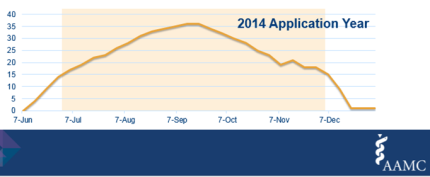To preface our comprehensive how-to guide for MD/PhD applications, we are providing a summary and timeline of the process. Overall, you’ll find that applying to MD/PhD programs is very similar to applying to medical school only (MD-only) programs, with just a few extra requirements!
Here are what we consider the 5 major steps to applying:
STEP 1: Ask for letters of recommendation
From who? Most medical schools require three letters of recommendation: two from science professors and one from a non-science professor. Additionally, MD/PhD programs need to see evidence of your research skills and therefore require a letter from each of your PIs. We will explore how to ask for and submit these letters in a later post.
When? Always provide a deadline when you request a letter; 4-8 weeks is very reasonable. This should give your recommenders ample time to write… and give you ample time to gently pester them when a letter or two has not been submitted on time. This almost ALWAYS happens (so try not to freak out when it does!). Since this step is largely out of your control, I generally advise speaking with professors by early March, even though you will not need the letters until May/June.
STEP 2: Submit transcripts to the American Medical College Application Service (AMCAS)
How? Once AMCAS opens, you will be able to access the transcript request form. Be sure to fill this out and give it to every university you have attended so they can mail in your transcript(s) to AMCAS. This step is an essential prerequisite for applying to MD and MD/PhD programs!
When? Submitting your transcripts will be important for verification of your application (see Step 3). It will take AMCAS a few days to receive your transcript, so I recommend doing this as early possible – either at the beginning of May when AMCAS opens or as soon as spring semester grades are available (usually mid-May) if you are still taking classes.
STEP 3: AMCAS
What is it? To apply to medical school, you need to fill out AMCAS. This is also called the primary application. Essentially, it’s a big application that the Association of American Medical Colleges (AAMC) sends to all of your chosen schools. We will dive into exactly what is required on AMCAS in a later post, but key sections include demographics, transcripts, work/activities, your school list, and three essays: one for all MD candidates and two that are MD/PhD-specific.
When? AMCAS typically opens on May 1, but you cannot submit it until the first week of June. Even then, your submitted application must be verified by AMCAS before it is actually sent to any of your schools. This means that AMCAS fact-checks the transcript you typed in line-by-line on the application with the transcript(s) you submitted in Step 2. Verification can take anywhere from a few hours to multiple weeks…see the chart below for more details! As you may notice, verification times generally increase until you reach a very late point in the application cycle. Thus, we will emphasize here and in later posts that APPLYING EARLY is critical.

AMCAS verification time in business days from the 2014-2015 application cycle (AAMC).
STEP 4: SECONDARY APPLICATIONS
What are they? Most programs have “secondaries,” or supplemental applications that are school-specific. Sometimes, these highly resemble the primary application. You’ll enter in more personal information, plus write a few more essays. We will provide strategies for these soon!
Who receives one? Some schools “screen” primary applications first. This means they only send secondaries to applicants who are serious candidates for their program; your AMCAS will be reviewed and you may be rejected pre-secondary. Most schools, however, automatically send a secondary to every applicant shortly after his/her AMCAS is verified.
When? If you submit AMCAS in June, I suggest completing secondaries by early August (before classes begin if you are still in school – this is key!) to be as early as possible.
STEP 5: INTERVIEWS
What are they? Once schools receive your AMCAS, secondary, letters of recommendation, and MCAT score, they will mark your application complete. At this time, they will decide whether or not they want to invite you to interview or if your application will no longer be considered. You cannot be accepted to a school without visiting the campus and interviewing in person.
Format: MD/PhD interviews are quite unique. In fact, this is likely the biggest difference you’ll see between the MD-only and MD/PhD application processes! Most MD-only interviews last half a day. As an MD/PhD applicant, you will usually be required to participate in these interviews with other MD-only candidates, plus do additional interviews with the MD/PhD side specifically. An average MD/PhD interview lasts 1-2 days and includes meetings with various researchers, chats with the program director(s), dinners with students or faculty, and maybe even a chance for you to give a short presentation about your research.
When? Typically from about August to January/February.
Again, please continue to check back in with us. You’ll soon see more detailed posts on what to search for in a program when creating your school list, what is required for the additional AMCAS essays, what a typical MD/PhD interview schedule looks like, and more! The full list of topics we plan to discuss can be found here.
In the meantime, feel free to email me at hayward@uab.edu with any questions or comments!
Emily Hayward
Incoming MD/PhD Student

[…] Overview and Timeline for MD/PhD Applications […]
[…] Overview and Timeline for MD/PhD Applications […]